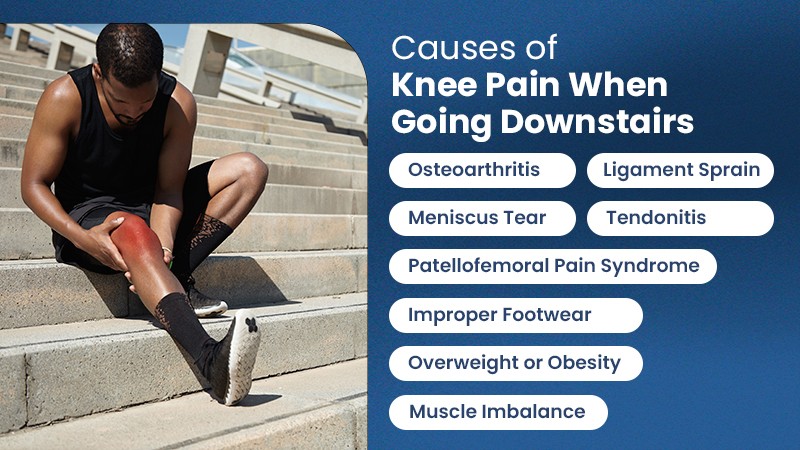Pain In The Knee When Going Downstairs

Why Do You Feel Pain In The Knee Going Downstairs? An Overview of Causes and Treatment
Many people complain of knee pain, especially as they begin to age. However, one frequent scenario includes experiencing knee pain when going downstairs. Descending stairs places significant stress on the knees, as they absorb the brunt of your body weight with each step. It can exacerbate underlying knee problems or trigger pain even in seemingly healthy joints.
This article explores the various reasons behind knee pain when going downstairs. We’ll look at various kinds of pain, possible causes, and successful treatment choices. Additionally, we’ll provide valuable tips for preventing knee pain and maintaining healthy joints.
Also read: What causes sudden knee pain without injury
Understanding Knee Pain When Going Downstairs
Knee pain while descending stairs can manifest in various ways. Here’s a breakdown of the different types of pain you might experience:
Sharp or Aching Pain: This type of pain often indicates an injury or inflammation within the knee joint.
Stiffness or Difficulty Bending: This feeling suggests a limitation in knee joint mobility, potentially due to arthritis or scar tissue.
Burning Pain: This discomfort might be a sign of nerve irritation or inflammation in the surrounding tissues.
Causes of Knee Pain When Going Downstairs

Several factors can contribute to knee pain while walking or going downstairs. Let’s explore some of the most common culprits:
Osteoarthritis: Cartilage degradation caused by this degenerative joint condition results in discomfort, stiffness, and trouble performing daily tasks like climbing stairs.
Meniscus Tear: The meniscus, a C-shaped cartilage disc, cushions the knee joint. A tear in the meniscus can result in discomfort, edema, and catching sensations while moving.
Patellofemoral Pain Syndrome (PFPS): Pain around the kneecap is a common symptom of this ailment, which is frequently brought on by poor kneecap tracking or recurrent stress.
Tendonitis: Pain during forceful activities, such as moving downstairs, can result from inflammation of the tendons surrounding the knee joint, such as patellar tendinitis.
Ligament Sprain: Sprains to the ligaments that stabilize the knee can cause pain, instability, and difficulty with weight-bearing activities.
Muscle Imbalance: Weak or tight muscles around the hip and knee can affect joint mechanics and contribute to pain during activities like going downstairs.
Overweight or Obesity: Being overweight puts extra strain on the knee joints, making pre-existing issues worse or producing discomfort.
Improper Footwear: Insufficient arch support and cushioning in shoes can lead to incorrect mechanics and knee discomfort.
Burning Knee Pain When Going Downstairs
Burning knee pain can be caused by several factors, including:
Pes Anserine Bursitis: Inflammation of the fluid-filled sacs (bursae) near the inner knee joint can cause burning pain, especially when going downstairs.
Baker’s Cyst: A fluid-filled cyst behind the knee can put pressure on surrounding nerves, leading to burning pain and discomfort.
Nerve Impingement: Burning, tingling, and numbness may result from compression of the nerves surrounding the knee.
For more you can read our blog on : What causes burning knee pain
Things to Avoid If You Have Knee Pain
Knee discomfort may be demoralizing, so it makes sense that you would want to go back to your regular activities as soon as possible. However, certain actions can actually hinder your healing process and potentially worsen your pain. It is a thorough explanation of what not to do if you are experiencing knee pain:
Ignoring Persistent Pain
Our bodies use pain as a signal that something is wrong. Ignoring persistent knee pain can be detrimental in the long run. While occasional aches might not require immediate attention, consistent pain warrants a visit to a healthcare professional for proper diagnosis and treatment. Prompt action can expedite healing by halting the advancement of pain.
Overexertion
Pushing yourself through activities that aggravate your knee pain might seem like a way to “work through it,” but it can backfire. Motions like sprinting and leaping severely stress the knee joint, and excessive stair climbing.
Continuing these activities can worsen inflammation, damage tissues further, and delay healing. It’s crucial to listen to your body and modify your activities until the pain subsides. Low-impact exercises like swimming or cycling can help maintain fitness without putting undue strain on your knees.
Applying Heat to Acute Injuries
While heat therapy is a valuable tool for managing chronic pain and promoting healing in later stages, it can actually worsen inflammation in acute injuries. In the first 24-48 hours after a knee injury (like a sprain or strain), applying ice packs for 15-20 minutes at a time is the recommended approach. Ice therapy helps reduce inflammation, swelling, and pain. Once the acute phase subsides, you can consider incorporating heat therapy as part of your pain management strategy.
Sudden Changes in Activity Level
Our bodies adapt best to gradual changes. If you’ve been relatively inactive and suddenly jump into a strenuous workout routine, it can overwhelm your joints, especially if you have underlying knee problems.
It can result in worsening discomfort and perhaps harm. Instead, concentrate on gradually increasing exercise. As your discomfort subsides, begin with low-impact workouts and progressively increase the time and intensity.
Self-Diagnosis and Treatment
While the internet offers a wealth of information, attempting to diagnose and treat your knee pain on your own can be risky. The cause of your pain could be more complex than you think, and improper treatment could exacerbate the problem. Consulting a pain specialist ensures an accurate diagnosis and allows them to create a unique treatment plan tailored to your individual needs.
Ignoring Medication Instructions
If your doctor prescribes medication for your knee pain, it’s crucial to follow the prescribed dosage and frequency religiously. Missing doses or taking more than the advised amount may harm medication efficacy, and undesirable side effects may result.
Neglecting Physical Therapy
Physical therapy plays a vital role in knee pain management and rehabilitation. A physical therapist can assess your specific condition, create a personalized exercise program, and teach you proper techniques to improve strength, flexibility, and range of motion in your knee joint. These stretches can lessen discomfort, stabilize the joint, and guard against further damage.
Following these recommendations can significantly contribute to a faster recovery and help you manage your knee pain while walking more effectively. Always remember that the best course of action for an accurate diagnosis and treatment of knee pain is to visit a healthcare provider.
Get In Touch With A Pain Specialist Now
Treatment Options for Knee Pain When Going Downstairs
Depending on the underlying reason, there are many treatments for knee pain. Here are a few typical treatment modalities:
Rest and Activity Modification: Reduction of pain-inducing activities promotes healing and recovery.
Ice Therapy: Pain and inflammation can be reduced by applying cold packs to the afflicted region for 15 to 20 minutes at a time.
Pain Medication: Over-the-counter pain relievers can help manage pain symptoms.
Physical Therapy: Exercises used in physical therapy can help with joint mobility, movement pattern correction, and strengthening of the muscles surrounding the knee joint.
Corticosteroid Injections: knee Injections can help reduce inflammation in specific areas of the knee joint.
Viscosupplementation: Injections of hyaluronic acid may help lubricate the knee joint.
Bracing and Assistive Devices
When descending stairs, some people find that wearing a knee brace or other assistive equipment offers more stability and support. Here’s a breakdown of some options:
Knee Braces: Braces come in various designs, offering compression, support, and proprioceptive feedback (improved joint awareness). For optimal fitting, choose a brace based on your unique needs and speak with a medical practitioner for further advice.
Canes: You can shift some weight and lessen the strain on your injured knee by using a cane on the side of the knee that hurts.
Handrails: Grasping a handrail for additional support can provide security and confidence when navigating stairs.
Preventing Knee Pain When Going Downstairs
Taking proactive measures can significantly reduce your risk of developing knee pain when going downstairs. Here are some preventive strategies:
Maintaining a Healthy Weight: Reducing extra weight eases the strain on the knees.
Strengthening Exercises: Regular workouts that target the quadriceps, hamstrings, and calves can help to build muscle strength and stability around the knee joint.
Stretching: Regular stretching practices that target the hamstrings, calves, and hip flexors can help increase knee joint flexibility and range of motion.
Proper Footwear: Choose shoes with strong arch support and cushioning to reduce impact during activities.
Downstairs Technique: Utilize a safe descending technique: lead with your stronger leg, take smaller steps, and descend slowly, focusing on controlled movements.
Alternative Methods: If feasible, consider using an elevator or taking the stairs less frequently to minimize stress on your knees.
Frequently Asked Questions
Is Inner Knee Pain Serious?
Inner knee pain can arise from various causes, some minor and others requiring medical attention. While not always serious, it’s important to consult with a healthcare professional for a proper diagnosis, especially if the pain is persistent, severe, or accompanied by swelling or instability. For more please read: What causes inner knee pain
How Long Does It Take For Inner Knee Pain To Go Away?
The timeframe for inner knee pain resolution depends on the underlying cause. Minor strains or overuse injuries may resolve within a few days with rest and self-care. However, more severe conditions like arthritis or meniscus tears might require longer-term treatment or even surgery.
End Word
Overall, having knee discomfort when descending stairs can be a frustrating and restricting situation. You may take charge of your knee health by being aware of the potential reasons and accessible treatments. Moreover, it is important to visit no pain nj or hazlet pain management center for comprehensive treatment. Dr. Faheem Abbasi specializes in pain management and conducts personalized treatments to lead an active life.
